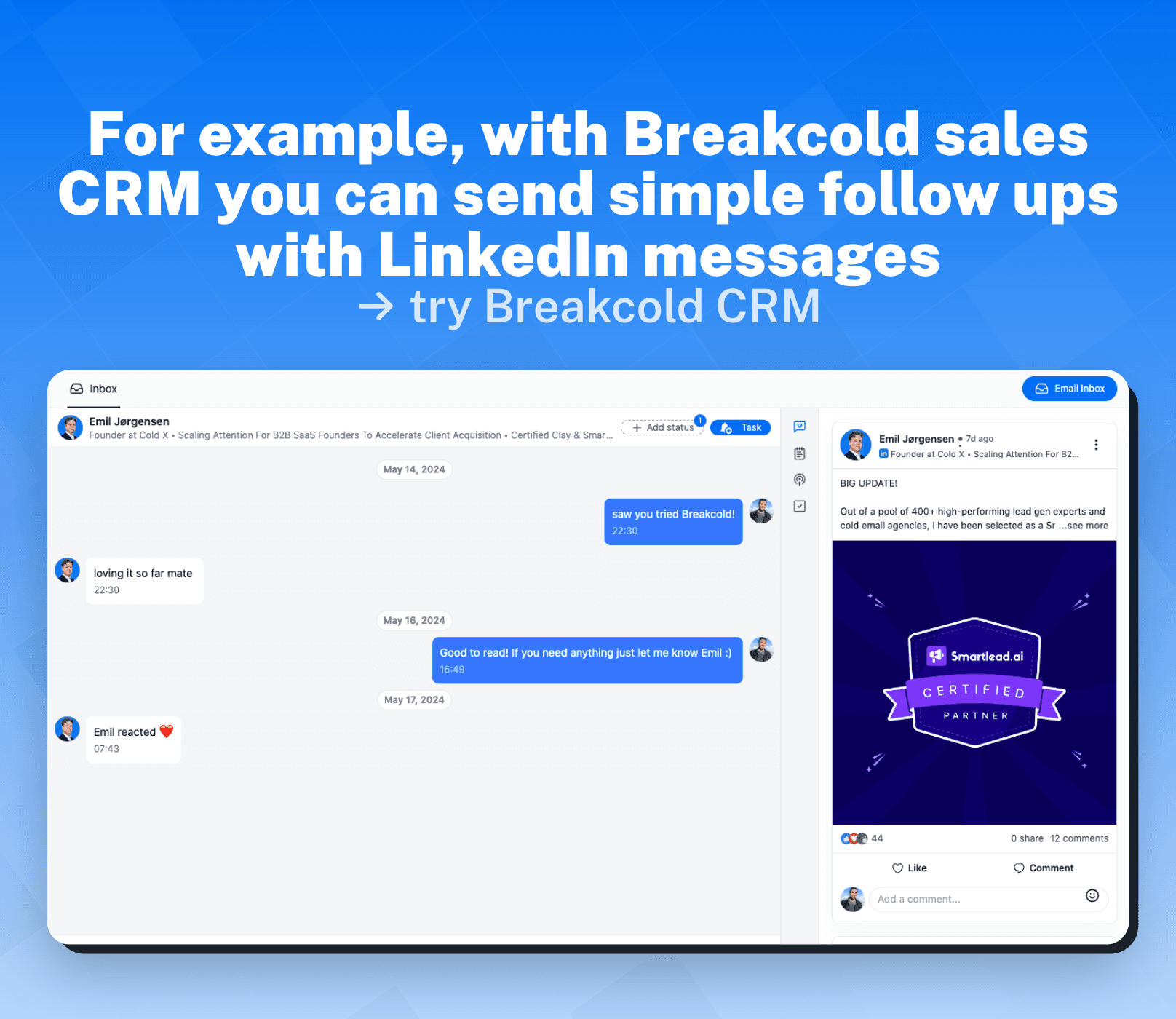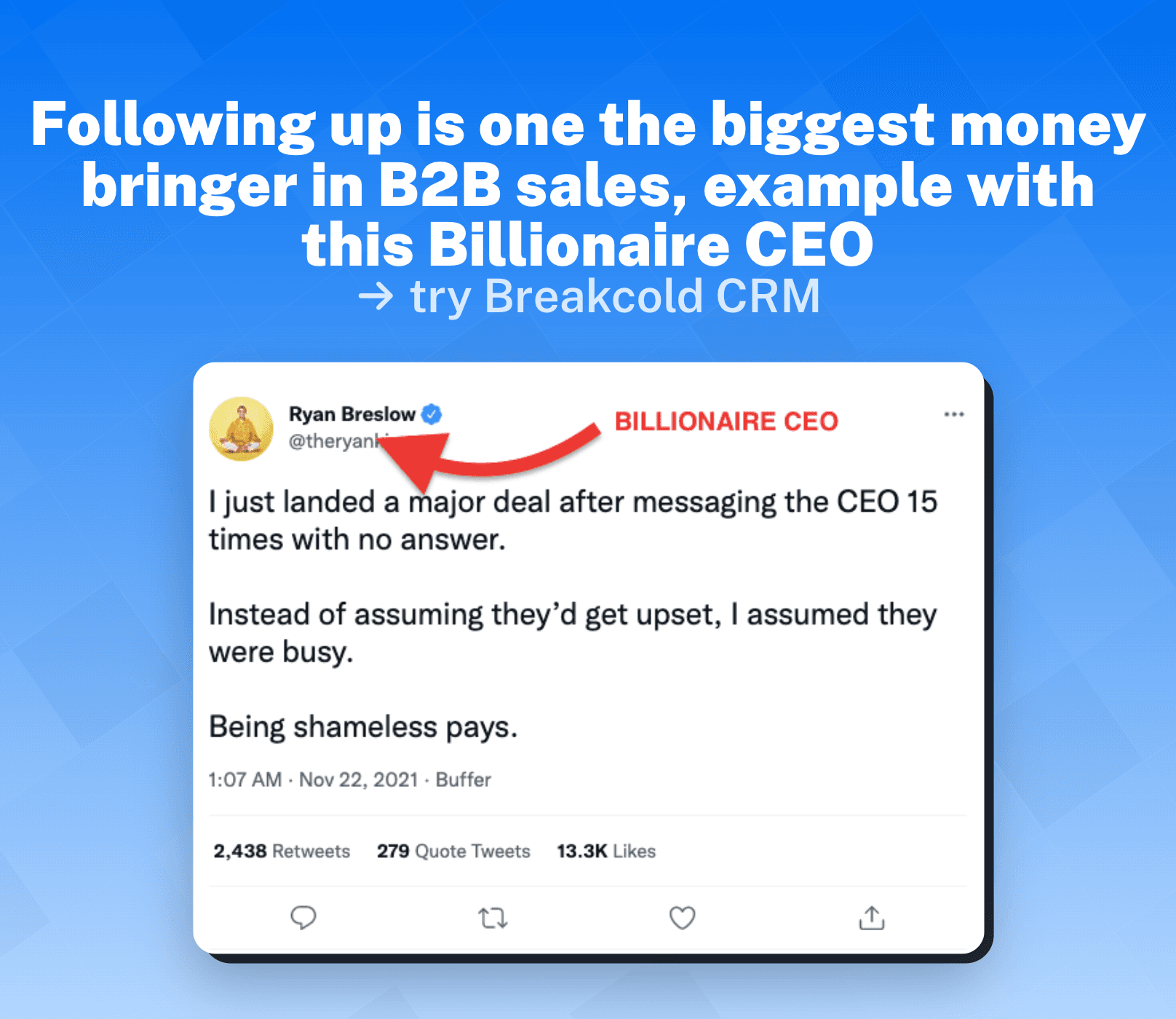
What is a Follow-Up? (Explained With Examples)
A follow-up is a crucial component of many professional interactions without crm automation. It refers to the action of continuing or reinforcing a previous communication or meeting. Whether it's an email, phone call, or face-to-face conversation, a follow-up helps ensure that the desired outcome is achieved, and nothing falls through the cracks. In this article, we will delve deep into what a follow-up entails and explore various examples to illustrate its importance and effectiveness in different contexts.
1°) What is a Follow-Up?
A follow-up can be defined as the act of pursuing or checking on something that has already occurred. It is an indispensable aspect of effective communication and consists of proactively reaching out to maintain or further a connection, resolve an issue, or request additional information.

1.1 - Definition of a Follow-Up
At its core, a follow-up involves actively engaging with someone after an initial interaction. It can take various forms, such as sending a thank-you note after a job interview, contacting potential clients after a sales pitch, or reconnecting with a colleague to discuss the progress of a project. Regardless of the specific situation, a follow-up serves to reinforce the previous communication and solidify the relationship.
For example, imagine you have just completed a job interview. After the interview, it is customary to send a follow-up email to express your gratitude for the opportunity and reiterate your interest in the position. This follow-up not only shows your professionalism but also keeps you fresh in the interviewer's mind, increasing your chances of being considered for the role.
1.2 - Advantages of a Follow-Up

The benefits of engaging in follow-ups are plentiful. Firstly, it demonstrates professionalism and attentiveness, showing that you value the other person's time and input. By offering to continue the conversation, you signal that you are invested in the relationship and committed to achieving the desired outcome.
Furthermore, a follow-up provides an opportunity to build rapport and strengthen the connection. For instance, if you have recently pitched a product or service to a potential client, following up allows you to address any concerns they may have had and provide additional information that could sway their decision in your favor.
Secondly, a follow-up provides an opportunity to clarify any misunderstandings or address unresolved issues. It allows both parties to align their expectations, building mutual understanding and trust.
Lastly, follow-ups can lead to positive outcomes such as securing a deal, gaining valuable feedback, or strengthening professional connections for future collaborations. By keeping the communication channels open, you increase the chances of success and facilitate ongoing cooperation.
1.3 - Disadvantages of a Follow-Up
While follow-ups offer numerous advantages, it is important to be mindful of their potential drawbacks. One common pitfall is coming across as too pushy or intrusive. Excessive follow-up attempts may annoy or alienate the other party, potentially damaging the relationship instead of strengthening it.
It is crucial to strike a balance between being proactive and respectful of the other person's boundaries. Understanding the appropriate frequency and method of follow-up is key to maintaining a positive and productive relationship.
Moreover, ineffective or poorly timed follow-ups can waste both parties' time and resources. It is crucial to assess the appropriateness and relevance of the follow-up before initiating it. A well-thought-out and tailored approach is essential to maximize the benefits of the interaction.

For example, imagine you have recently connected with a colleague to discuss the progress of a project. If you continuously follow up without any new updates or relevant information, it may be seen as unnecessary and burdensome. Instead, it is important to ensure that each follow-up serves a purpose and adds value to the conversation.
In conclusion, follow-ups play a vital role in effective communication. They allow for continued engagement, clarification of expectations, and the potential for positive outcomes. However, it is crucial to approach follow-ups with tact and consideration to avoid potential disadvantages. By striking the right balance, follow-ups can contribute to the success and growth of professional relationships.
2°) Examples of a Follow-Up

Now that we have explored the concept and advantages of follow-ups, let's delve into some real-life examples across different professional contexts:
2.1 - Example in a Startup Context
In the startup world, a follow-up can make or break a deal. Let's say you pitch your innovative product to a potential investor who shows genuine interest. Following up with a thank-you email, attaching relevant materials, and offering to address any questions they may have can significantly increase your chances of securing funding.
Additionally, in this context, a follow-up can also involve scheduling a follow-up meeting or call to discuss the next steps. This proactive approach demonstrates your commitment and professionalism, leaving a lasting impression on the investor.
Furthermore, it is crucial to personalize your follow-up communication based on the investor's specific interests and concerns. By addressing their individual needs, you can tailor your follow-up to resonate with them on a deeper level, increasing the likelihood of a positive outcome.
2.2 - Example in a Consulting Context
In the consulting industry, a follow-up is pivotal to maintain a strong rapport with clients. After delivering a workshop or presentation, reaching out to participants with a recap of the key takeaways and offering further resources showcases your commitment to their success. It also opens the door for potential future collaborations.
Moreover, in a consulting context, a follow-up can extend beyond a simple email. It may involve scheduling follow-up meetings to discuss the implementation of recommendations or providing additional support and guidance as clients navigate through the changes suggested during the consulting engagement.
Furthermore, a well-crafted follow-up can serve as an opportunity to gather feedback from clients, allowing you to continuously improve your services and tailor future engagements to their specific needs.
2.3 - Example in a Digital Marketing Agency Context

For a digital marketing agency, a follow-up can be indispensable in nurturing leads and converting them into loyal clients. Following an initial meeting or proposal, sending tailored case studies, testimonials, or success stories can reinforce your agency's expertise and build confidence in your abilities.
Additionally, in this context, a follow-up can also involve providing potential clients with a comprehensive marketing strategy or campaign proposal. This detailed follow-up not only showcases your agency's capabilities but also demonstrates your dedication to their specific business goals.
Furthermore, a follow-up in a digital marketing agency context can include offering a complimentary consultation or audit to further demonstrate the value your agency can bring to their business. This personalized approach can help potential clients envision the positive impact your services can have on their digital presence with crm for agencies
.
2.4 - Example with Analogies
To further emphasize the value of follow-ups, let's explore two analogies:
Imagine you are a gardener. Planting seeds is only the first step towards a flourishing garden. To ensure optimal growth, you must water, fertilize, and tend to the plants consistently. Similarly, follow-ups nourish professional relationships, facilitating their development and yielding fruitful outcomes.
Furthermore, think of a follow-up as a thread that weaves together the fabric of meaningful connections. Without it, the fabric remains loose and fragile. By consistently reinforcing the bond, the connection becomes stronger, enabling collaborative achievements.
In conclusion, a follow-up is a vital tool in any professional's arsenal. It establishes rapport, clarifies intentions, and fosters collaboration. By understanding what a follow-up encompasses and examining real-life examples, we can harness its power to achieve our goals and cultivate fruitful relationships. So, the next time you find yourself contemplating a follow-up, remember its potential and make the choice to take action!
Remember, follow-ups are not limited to the examples provided above. They can be adapted to various professional contexts, such as sales, networking, job applications, and project management. The key is to understand the specific needs and expectations of the situation and tailor your follow-up accordingly.
By investing time and effort into follow-ups, you demonstrate your commitment, professionalism, and genuine interest in building strong relationships. So, don't underestimate the power of a well-crafted follow-up. It can be the difference between success and missed opportunities in your professional endeavors.











































































































































































































